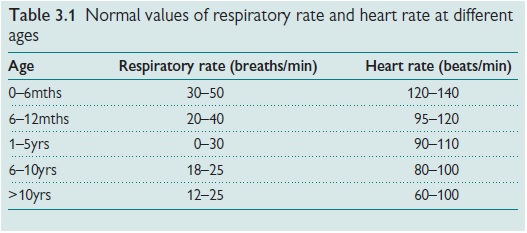Chapter: Paediatrics: Clinical assessment
Paediatrics: Vital signs
Vital signs
See Tables 3.1 and 3.2 for normal
values of respiratory rate, heart rate (HR), and BP at different ages.


·
Temperature: there are various ways in which
the body temperature can be measured.
Different units use different methods:
an electronic thermometer in the
axilla;
a chemical dot thermometer in the
axilla; or
an infrared tympanic thermometer.
·
A sick
child could have a high, or abnormally low, temperature.
·
Pulse rate: the pulse rate should be assessed
from the radial pulse. (In the
younger child you may find it easier to use brachial pulse.) Assess the rate,
character, and rhythm at the radial pulse.
·
Respiratory rate: in the older child you can observe
the chest and count the number of breaths/min.
Breaks or pauses in breathing that last longer than 15s are abnormal. In the
infant, count abdominal movements over 1min, if you find it is easier to see
diaphragmatic, rather than chest wall movement.
· BP: measurement is commonly performed using an automated method with BP displayed on-screen. It is important that the size and width of the cuff is appropriate for the size of limb in which pressure is being measured. It should cover 50–75% of the upper arm or thigh. A single measurement is required in most cases, but if heart disease is suspected, 4-limb measurements are needed. If considering hypertension, a standard technique is required; plot observations on BP centile charts
Related Topics